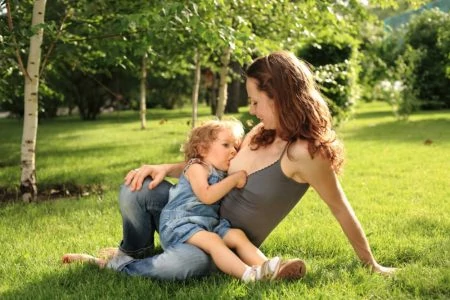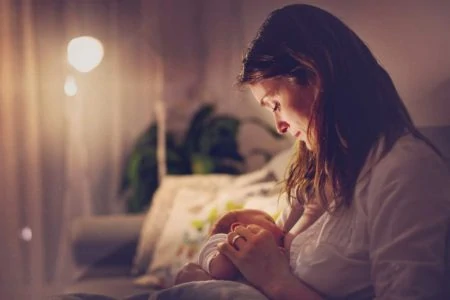Many new mothers panic when they don’t see white liquid flowing immediately after delivery. It is easy to assume something is wrong, but biology has a schedule of its own.
If you are checking your breasts every hour and wondering where the milk is, take a deep breath. We will walk you through exactly what is happening, what to look for, and how to know your baby is getting fed.
Key Takeaways
- Milk production starts during pregnancy (Lactogenesis I), but the high-volume mature milk typically arrives 2 to 5 days after birth (Lactogenesis II).
- In the first few days, your body produces colostrum. It is low in volume but packed with antibodies and nutrients perfectly suited for a newborn’s marble-sized stomach.
- Signs your milk is coming in include breast fullness, warmth, firmness, and hearing your baby gulp or swallow audibly.
- To speed up the process, nurse frequently (8 to 12 times a day) and practice skin-to-skin contact to spike your milk-making hormones.
Where Is My Milk?
After my son was born, I expected to wake up in a puddle of milk. But biology doesn’t work like a faucet. Even though your body starts preparing milk in the second trimester, you likely won’t see the white, flowing liquid you expect until day three or four postpartum.
So, is your baby starving in the meantime? Absolutely not.
Your body is currently serving the “first course” called colostrum. This thick, golden fluid is often called liquid gold. It is highly concentrated and packed with protein, antibodies, and white blood cells. Think of it as a superfood shot rather than a large meal. Your newborn’s stomach is tiny, so they only need teaspoons, not ounces, right now.
A Common Concern
The First 5 Days: A Timeline
I had no clue what to expect those first few sleepless nights. Google was my best friend at 3 a.m. Every mother has a slightly different timeline, but here is the general progression of how your milk supply changes.
If you had a C-section or a traumatic birth, this timeline might shift slightly. That is okay.
Day 1: The Golden Hour
Your colostrum is ready immediately. The goal here is stimulation. Try to get that first latch within the first hour of birth if possible. Your baby might be sleepy and only eat small amounts, but frequent attempts help signal your body to start the factory.
Day 2: The Cluster Feeding
This is often the hardest day. Your baby may seem clingy and want to eat constantly (cluster feeding), especially at night. This is not a sign of low supply; it is a biological order. Your baby is putting in the request for more milk. Keep them at the breast as much as possible.
Day 3: The Transition
You should continue demand-feeding every two to three hours. If your baby struggles to latch, hand expression is a great tool. You can express drops of colostrum onto a spoon to feed the baby. This keeps them fed and tells your body to boost the milk supply. If latching hurts or fails, call a lactation consultant immediately.
Day 4: The Arrival
Hello, engorgement. You will likely feel your breasts becoming heavy, warm, and firm. This is the hallmark sign that your milk volume is increasing rapidly. Your baby may get frustrated because a hard breast is difficult to latch onto.
Focus on softening the areola before feeding to help them get a grip.
Day 5: Establishing Routine
Your baby should be gulping audibly now. Feedings may space out slightly because they are getting a fuller tummy at each session. Your body is now in production mode, and you will start to learn your baby’s hunger cues.
Colostrum vs. Mature Milk
How do you know the switch has flipped? The difference is usually obvious once you inspect the liquid and your baby’s behavior:
- Colostrum: This is usually yellow or orange (golden) and very thick. It comes out in drops. It can also be clear. It is low volume but high calorie.
- Mature Breast Milk: This comes in much higher volumes. It transitions to a thinner consistency that looks like skim milk or watery cow’s milk. The color shifts to white, cream, or even a blueish tint. Milk color changes are normal. Your baby will seem “milk drunk” and satisfied for longer stretches after feeding (1).
The more you nurse, the faster this transition happens. If you supplement with formula, your body doesn’t get the signal to produce more, which can delay your milk coming in.
What Does “Milk Coming In” Feel Like?
When “Lactogenesis II” hits (the fancy term for milk coming in), you won’t miss it. Your breasts will likely feel rock hard, warm to the touch, and significantly larger. You might even see veins popping out that weren’t there before.
You may also feel a “let-down” sensation. This can feel like pins and needles, a tingling sensation, or a dull ache deep in the breast when the baby starts sucking or even when you hear them cry.
Some women experience leaking around this time, while others don’t. When I had my first baby, I woke up in the middle of the third night to a soaked bed and rock hard breasts. Feeding frequently helped tame the fullness and the leaking.
Editor's Note:
Michelle Roth, BA, IBCLCIf you experience toe-curling pain during breastfeeding, unlatch and try again. Pain is a sign of a bad latch, not just milk coming in.
You should also listen. The sound changes from small clicks to rhythmic “suck, swallow, breathe” patterns. You will hear the swallows.
4 Ways To Manage Engorgement and Tenderness
When the floodgates open, it can be uncomfortable. Engorgement is a sign of plenty, but it can lead to sore nipples and clogged ducts if not managed. Here is how to handle the sudden fullness.
1. Mind Your Nipples
Sore nipples are the most common complaint in week one. However, cracked, bleeding, or lipstick-shaped nipples usually indicate a shallow latch. Aim for a deep latch where the nipple hits the soft palate in the back of the baby’s mouth.
Use a lanolin-based cream or express a little breast milk onto your nipples and let it air dry to speed up healing.
2. Move The Milk
The only cure for full breasts is to empty them. Keep the baby on the breast frequently. If your baby is too sleepy to empty you, use a breast pump or hand express for a few minutes to relieve pressure.
Don’t over-pump, however. Pumping too much can create a massive oversupply, which brings its own set of problems. Pump just to comfort.
If your breasts are too hard for your baby to latch, it helps to pump briefly before bringing your baby to the breast. Or consider reverse-pressure softening (2).
Editor's Note:
Michelle Roth, BA, IBCLC3. Support The Girls
Your pre-pregnancy bras likely won’t fit right now. You need a stretchy, supportive nursing bra without underwire. Underwires can press on milk ducts and cause clogs during this engorgement phase.
4. Use Cold and Heat Correctly
Temperature is your friend.
- Heat: Apply a warm compress or take a warm shower before nursing. This helps the milk flow and triggers a let-down.
- Cold: Apply cold packs (or the classic chilled cabbage leaves) after nursing. This reduces swelling and inflammation.
Are You Producing Enough? (The Checklist)
In the haze of new motherhood, it is hard to trust your body. Forget about measuring how much you pump (pumps are less efficient than babies). Instead, look at the output.
If your baby is meeting these milestones, your milk has successfully come in:
- The Diaper Count: This is the most reliable sign. By day five, expect at least 6 heavy wet diapers and 3 to 4 yellow, seedy stools (mustard color) every 24 hours. Dark, sticky meconium should be gone.
- Weight Gain: Babies lose weight initially (up to 7-10% of birth weight). Once milk is in, they should stop losing and start gaining back roughly an ounce a day.
- Contentment: Your baby should seem relaxed and “milk drunk” (limp arms, open hands) after a feed. If they are constantly fussy and sucking on their hands immediately after a long session, they might still be hungry.
If you aren’t seeing yellow poop by day five, or if diapers are dry, call your pediatrician immediately.
FAQs
Trust the Process
Waiting for your milk to come in can feel like the longest week of your life. But remember: your body knows what to do.
Watch the diapers, not the clock. If your baby is wetting diapers and making that transition to yellow poop, you are doing a great job.
If things feel off, or your mother’s intuition is nagging you, never hesitate to reach out for help. Lactation consultants are there to be your village. You’ve got this!















